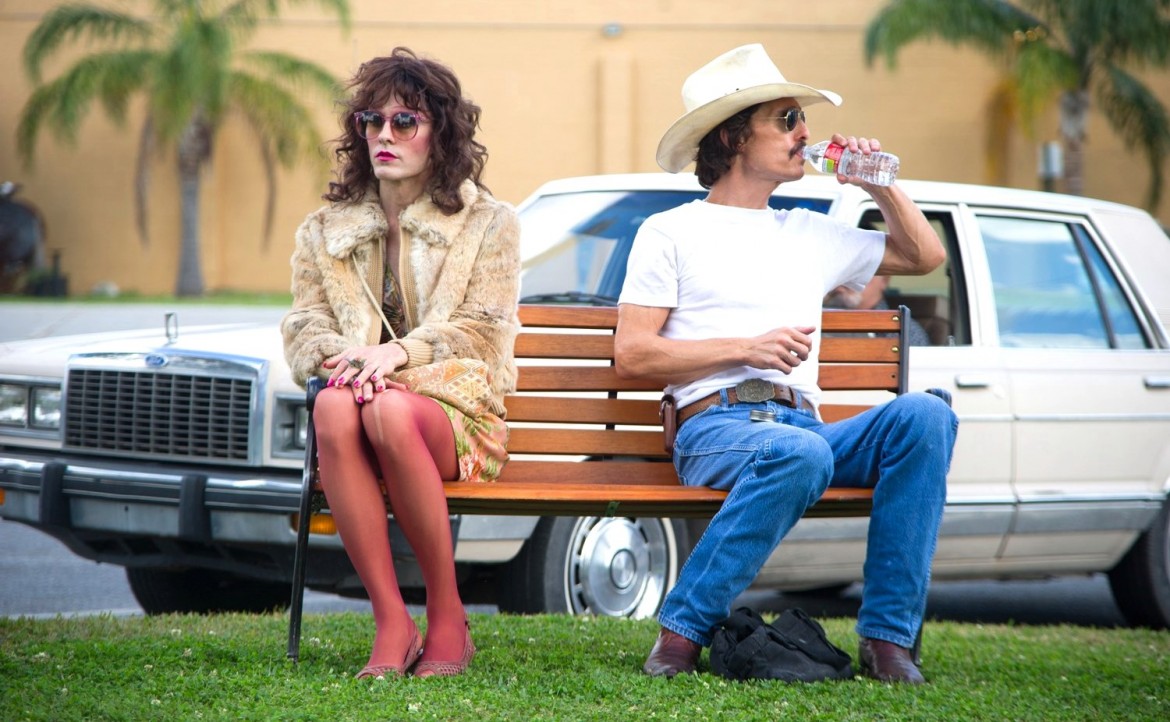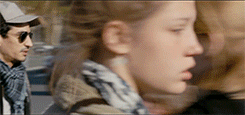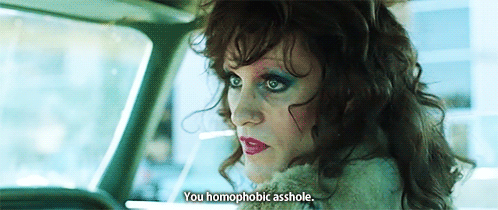Why Are The Only Gay Films Getting Mainstream Attention Those Made By Straight Men?
'Dallas Buyers Club' and 'Blue Is The Warmest Colour' raise questions about the role cinema plays in telling the stories of sexual minorities.

A man falls ill, and when seeking treatment he falls for the pretty doctor who is treating him. Sounds like the plot of a three-tissue weepy romance, the kind you’d expect to see on a fringe channel of Foxtel that usually features all-day Hart Of Dixie marathons. In this case, however, the man is played by an emaciated Matthew McConaughey, and the illness he’s struck down with is AIDS. The film — Dallas Buyers Club, by Canadian director Jean-Marc Vallée — has struck as much controversy for its heterosexual white-washing of the ’80s AIDS outbreak and its presentation of transgender women, as it has elicited teary-eyed praise for bringing the crippling disease back to the mainstream after at least a decade of receding news attention.
Also out this week is the three-hour French romance Blue Is The Warmest Colour, which charts a years-long relationship between two young women, played by Adèle Exarchopoulos and Lea Séydoux. Featuring extended, frank sex scenes and two powerhouse performances, the Cannes Palme d’Or winner from writer/director Abdellatif Kechiche has been hailed as a groundbreaking representation of lesbian sexuality on screen that confronts audiences with the highs and lows of a long-term relationship.
Ignoring the curious coincidence of having two LGBT-themed movies released in the same week, and especially on the weekend of Valentine’s Day — audiences going to the latter for a bit of ooh-la-la eroticism will likely leave the cinema exhausted more than aroused — the two films present altogether more confounding quandaries about the role cinema plays in telling the stories of sexual minorities.
Does not being a member of the LGBT(QIA — the acronym appears to lengthen by about one letter per year) community disqualify somebody from making a film about these issues? Not at all. Many of the very best were directed and acted by heterosexual men and women — Brokeback Mountain (2005), My Beautiful Laundrette (1985), and Vallée’s own C.R.A.Z.Y. (2005) are testament to that. But should they face higher scrutiny? Perhaps. Just as with directors making biopics of a famous person or a white filmmaker telling the story of another race — think the casting snafus of Memoirs Of A Geisha (2005) or the historical revision of The Last Samurai (2003) and 47 Ronin (2013) — it’s not really the director who gets to decide whether their portrayal is authentic or inoffensive, but rather the people whose stories and histories are being used to sell tickets.
–
Accidental Acceptance In Dallas, Texas
In making the first star-laden, mainstream film about the AIDS epidemic since Philadelphia (1993), and having it be about a bigoted straight man who falls ass-backwards into accepting gay people as more than freaks and faggots out of convenience, Dallas Buyers Club struck a foul-tasting chord. No, AIDS wasn’t strictly a ‘gay man’s disease’, as it was so frequently labeled at the time, but it’s hard not to call shenanigans when the film not only shunts any truly authentic portrayal of homosexual AIDS suffering, but also suggests McConaughey’s Ron Woodruff should be celebrated and hailed as a revolutionary for (like movie studios) making money off victims while romancing the ladies in his down time. You can almost see the fistpump that happens when Ron discovers a HIV-positive woman with whom he can root in the broom closet, as if to shout, “At last!”
It was nice that Woodruff — a real person who it turns out was likely openly bisexual — decided to help his fellow sufferers, but this interesting footnote in AIDS history is played safe and straight all the way. As John Oursler wrote in his fabulous Sound On Sight article, it’s portrayed “as if one good deed compensates for a decade’s worth of willful ignorance.” And aren’t he and Jennifer Garner so cute together? #facepalm
The character of Rayon, a transgender woman played by Jared Leto, is particularly troublesome, despite the affecting performance underneath the rouge-tinted make-up and hot pink stockings that overlay Leto’s gaunt figure. Used as a pawn to milk tears out of audiences, she’s all but thrown under the bus by the film’s end. And when one character dies late in the film, their painful, ugly death is counter-balanced by goofy sequences in which McConaughey wears big Texan hats and flirts with female airport staff as he attempts to smuggle illegal drugs into the country. That’s how much reverence Vallée has for the struggles of gay people who suffered with AIDS: while they were dying, a straight man was changing the world. Perhaps I’m being somewhat facetious, but where’s the film about the gay man starting up a ‘buyers club‘? Why not tell that story?
–
Love In The Time Of Heterosexuality
Next week marks the 20th anniversary of the death of Derek Jarman, one of the most inspirational and acclaimed directors of his time. Openly gay, and towards the end of his career openly HIV-positive, Jarman made films that were explicitly gay. Not explicit in the way of Kechiche’s Blue Is The Warmest Colour and its graphic 15-minute lesbian sex scenes, but explicit in that they focused on all facets of homosexual life, whether they be period, contemporary, or other (his final film, Blue, is an 80-minute rumination on life set to the visual of a single blue screen). I recently attended a retrospective in New York City’s Museum Of Modern Art for another gay filmmaker, Isaac Julien, whose films are similarly out and open. We should be lucky that Gus Van Sant got to Milk (2008) — his biopic about pioneering San Francisco politician, Harvey Milk — before someone less inclined morphed him into a sexless bureaucrat.
So why does it seem like the only films dealing with gay issues to get mainstream attention lately are ultimately by or about straight men? As I discussed on Junkee last December, there were plenty of gay-themed movies in 2013 and there’s plenty to come in 2014, but you’d be hard-pressed to find people who’d seen them. Why, for instance, was the equally explicit Stranger By The Lake from gay French director Alain Guiraudie relegated to a second-string strand of the Cannes Film Festival when Blue Is The Warmest Colour was given prime Palme d’Or-competing real estate?
Likewise, lesbian filmmaker Stacie Passon won acclaim and a prestigious prize from the Berlin International Film Festival for her debut feature Concussion, and yet this mature, sensual, and evocative film about mid-life sexual self-discovery has gone underseen in America and unreleased in Australia. Maybe if its central character — a woman who begins prostituting herself without her suburban family’s knowledge — were a heterosexual woman who reveled in titillating, marathon sex scenes, it would have been a bigger hit.
–
Ignorance Makes The Heart Grow Angry
For all of Blue Is The Warmest Colour’s strengths — from its powerful acting to its screenplay that states harsh truths about love and breaking up — Abdellatif Kechiche openly stated at a New York Film Festival Q&A session that he has little interest in LGBT or queer cinema, stating that his favourite is, ahem, Ben-Hur. With Dallas Buyers Club, director Jean-Marc Vallée has sadly shown ignorance to the wider story he’s telling, as though he didn’t quite grasp the gravity of the effect stories about AIDS have on gay audiences. Predictably, his film has been nominated for ‘Best Picture’ at the Academy Awards, and McConaughey and Leto are odds-on favourites to win their acting races.
While gay film-lovers have more viewing options now, it’s still titles like Dallas Buyers Club and Blue Is The Warmest Colour that become the high-profile beacons for LGBT subject matter. If their makers don’t want to be called out in the way that Julie Maroh (the author of the original Blue Is the Warmest Colour graphic novel) did in labelling the adaptation “a brutal and surgical display… which turned into porn”, or taken to task for their insensitivities like Leto was after his alarming Golden Globes speech, then they should be trying harder to understand the people they’re making movies about.
–
Blue Is The Warmest Colour and Dallas Buyers Club both open in cinemas today.
–
Glenn Dunks is a freelance writer and film critic from Melbourne, and currently based in New York City. His work has been seen online (Onya Magazine, Quickflix), in print (The Big Issue, Metro Magazine, Intellect Books Ltd’s World Film Locations: Melbourne), as well as heard on Joy 94.9.

